German Battlecruiser SMS Seydlitz
Battlecruisers were a hybrid type of ship, invented by the British in 1906. They were designed to have the firepower of a battleship combined with the speed of a cruiser. To achieve this, the armor had to be reduced, which turned out to be disastrous.
The German answer to this new type of ship was the Große Kreuzer, the large cruiser. Nowadays they are usually called battlecruisers too. They were slightly slower and had slightly lighter artillery than their British counterparts, but were much better armored. The German battlecruisers were arguably the best ships of their time. The other main contender for this title are the battleships of the Queen Elisabeth Class.
The SMS Seydlitz was the fourth German battlecruiser, built before WW1. The lessons learned from the earlier battlecruisers, Von der Tann, Moltke and Goeben were incorporated into her design.
Like her distant relatives, the Bismarck, Tirpitz and Scharnhorst of WW2, Seydlitz took some terrible punishment, but gave as good as she got.
During the Battle of Doggerbank, the 24 January 1915, she was hit by a shell from HMS Lion, that penetrated the barbette of the aftermost turret. The propellant charges in the barbette caught fire and the turret was filled with smoke and poisonous gas. The crew of the turret fled into the adjacent turret, but the fire followed them through the opened doors. Both turrets were completely burned out and 165 seamen lost their lives.
The heat of the fire threatened to ignite the shells in the shell room below. The heat scorched Pumpenmeister Wilhelm Heidkampfs hair and eyebrows as he went into the shell room, which was filled with smoke and poisonous gas. Groping his way forward, with his gas mask on, he found the red hot flooding valves and opened them with his bare hands, thus saving the ship and the lives of his shipmates.
The Seydlitz, assisted by SMS Derfflinger gave as good as they got and hit the HMS Lion so hard, that she had to be towed back to port.
The hit on the Seydlitz turned out to be a blessing in disguise. After the battle, the Germans rebuilt their turrets, to prevent anything similar from happening. The British did not learn this lesson, which was to have disastrous consequences.
The 31 of May 1916 Seydlitz took part in the Battle of Jutland, the only major clash between the Hochseeflotte and the British Grand Fleet. During the first phase of the battle, the Seydlitz and the Derfflinger sunk the HMS Queen Mary, which blew up and broke in two after being hit in the magazine. She was the second of three British battlecruisers sunk in this way during the battle.
The Seydlitz, on the other hand was hit by a torpedo, and artillery hits put two of her turrets out of action. She was still able to maintain full speed.
During the main phase of the battle, she was hit again, but hit the HMS Colossus twice. When darkness fell and the main battle ended, she had been hit by a total of 21 heavy shells and one torpedo. With her foreship lying deeper and deeper she struggled to reach her home port. Robust design, good seamanship and calm weather saved her. She reached Wilhelmshafen with 5000 tons of water aboard and her foredeck awash.
During 1917 she took part in some raids on the North Sea, but there was no contact with the enemy.
After the war, on the 21 June 1919, she was scuttled in Scapa Flow along with the rest of the Hochseeflotte. The wreck was salvaged 1928 and then scrapped.
Combrigs resin kit is the only kit of a German battlecruiser in 1:350. It’s an excellent kit, but it suffers from the typical shortcomings of Combrigs kits. The instructions are very scarce and there was transportation damage on several parts.
Therefore, you need good reference material to build the kit. Luckily there is plenty on the internet, but best of all is Gary Staffs book "German Battlecruisers of WWI". It's an expensive book, but a gold mine for naval buffs like me.
The hull is divided in an upper and a lower part, which caused the usual purgatory of having to try to conceal the joint.
I detailed the model further with hull plating made from 0,1 mm Styrene sheet and put ”eyebrows” made from copper wire above the portholes.
The entire torpedo net arrangement was scratch built. I made the booms from piano wire and copper wire and the nets from wool yarn, dipped into diluted white glue.
I painted the deck with my usual method of masking individual planks in three stages using four different shades of wood color.
The kit contains a beautiful set of ships boats but there are no cradles or rails in the deck for them.
I solved the problem by depicting the ship as she would have looked during the Battle of Jutland. The ships boats were left in port when going on a combat mission and the booms for the cranes and the davits were taken down and lashed to the deck. The rear funnel was painted red for recognition.
I swung out the main artillery to starboard, like it was swung out during the first phase of the Jutland battle, the moment of her greatest triumph.
I wrote an extensive article about the build, which was published in the March issue of Fine Scale Modeler.
For German speaking readers, there is an even more extensive article in two parts in the June and July 2016 issues of ModellFan.
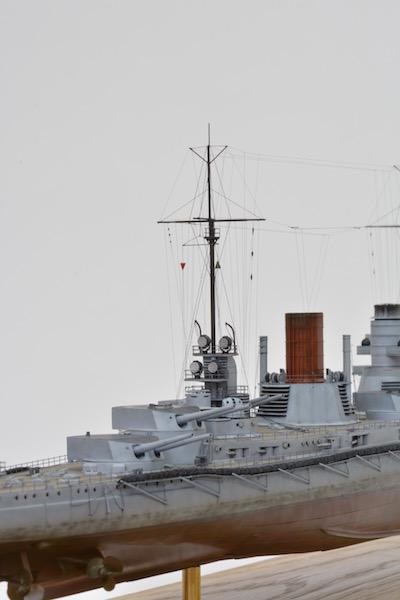
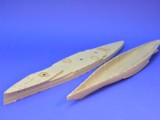
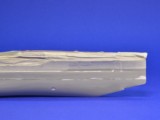

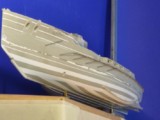
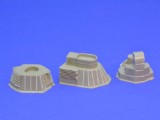
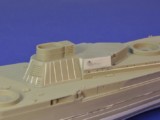
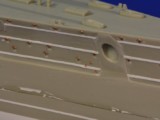
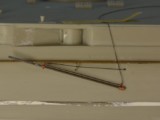
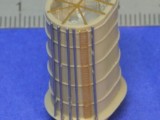

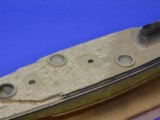
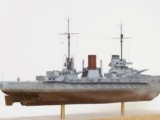
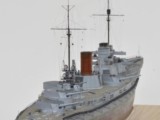
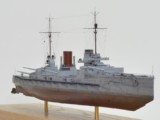

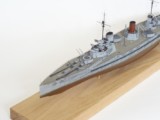
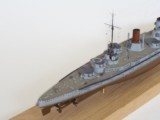
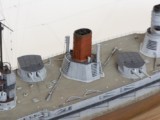
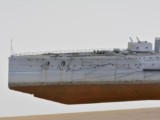
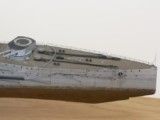
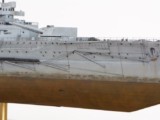
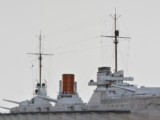
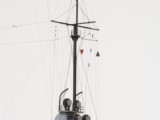
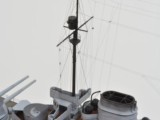

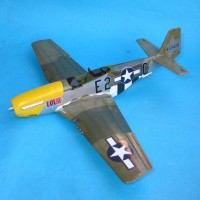
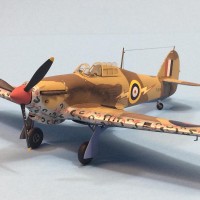
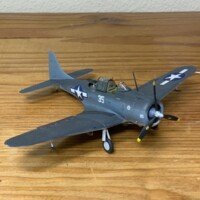
Ulf, amazing that she took all that punishment, managed to keep up her speed, and to regain her home port without sinking. That turret fire at Dogger Bank was a blessing in disguise, though the cost in men was not good.
Quite a story!
Nice work Ulf.
Ulf, a very nice / interesting model. Great story. She looks ahead of her time, given the era it served in. Thanks for sharing !
Beautifully built. Another gem.
Another Ulf masterpiece.
Exquisite work as always, sir...good to see you back "on board". 🙂
Amazing as usual Ulf! Great article to go with it as well. The desk masking must have taken some time...
Fantastic job! This one is a masterpiece. I really like it.
Beautiful! While I happen to be an armor & aircraft fan, (and model building) I LOVE and admire good ship models and yours are some of the best I've ever seen! Ausgezeischnet!
A great build! and an interesting history lesson.
Lovely work Ulf - she's a beauty!
Great article, the history and back round of the ship design goes along way in allowing the reader/viewer to have a better understanding of the ship and the model.Which has been beautifully weathered and painted.
This model and article is a strong candidate for model of the month.
Two thumbs up Ulf.
While I have little interest in ships I always enjoy reading your articles and admiring your models, and this is no exception, thanks for posting this, Ulf.
Absolutely wonderful work...very nice ship, congrats Ulf..Another Masterpiece...Regards.
Very nice SEYDLITZ, including the red funnel.
Of all the warship books I have, Gary Staff's volume on WW1 German battlecruisers is, IMO, the best book I have. It wasn't until I got my copy that I read about the red funnels; no other book I have about the HSF ever mentioned that. Staff's research, like your model builds Ulf, are simply the best. GREAT WORK!
The red funnels were painted on these 2 old battle cruiser models in 1:1536 (Lutzow, Seydlitz) AFTER I bought Gary Staff's outstanding volume. DFO
1 attached image. Click to enlarge.
Thanks again Dennis!
Yes, Gary Staffs book is a gem!